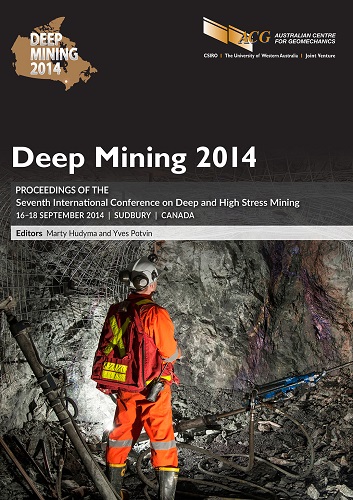Towards mining schedule optimisation constrained by geomechanics

|
Authors: Saeidi, N; Millar, D; Fava, L; Cai, M |
DOI https://doi.org/10.36487/ACG_rep/1410_33_Saeidi
Cite As:
Saeidi, N, Millar, D, Fava, L & Cai, M 2014, 'Towards mining schedule optimisation constrained by geomechanics', in M Hudyma & Y Potvin (eds), Deep Mining 2014: Proceedings of the Seventh International Conference on Deep and High Stress Mining, Australian Centre for Geomechanics, Perth, pp. 485-498, https://doi.org/10.36487/ACG_rep/1410_33_Saeidi
Abstract:
This paper reports work-in-progress that has the aim of incorporating geotechnical constraints on the optimisation of schedules of underground mine excavation activities. Optimal mine schedules are those for which the net present value (NPV) is maximised under a given financial model. The approach aims to consider the visco-elastic behaviour of rock when analysing the stability of excavations for constraint formulation. Changes in deviatoric stress around multiple, sequential openings or excavations are mapped and are shown to be influenced by both changes in the time between excavation events and the sequence of excavating events. The results of this analysis are presented in this paper. The approach is predicated on a causality principle for mine seismicity which requires a time dependent response (visco-elastic or possibly visco-elasto-plastic) of the rock mass. This is potentially difficult to conceive for rock masses at great depth, but is nevertheless evidenced by mine seismicity records from deep level mining operations, some of which are reviewed in this paper. The output of these geotechnical sequencing studies will ultimately be cast as constraints on a mine schedule optimisation process.
References:
Adams, GR & Jager, AJ 1980, ‘Petroscopic observations of rock fracturing ahead of stope faces in deep-level gold mines’, African Institute of Mining and Metallurgy, vol. 44, pp. 204-209.
Beneteau, DL 2012, M.Sc. thesis, ‘A study relating Time-Between-Events (TBE) to seismic source mechanisms in hard rock mining’, Laurentian University, Sudbury.
Bieniawski, ZT 1976, ‘Rock mass classification in rock engineering’, in ZT Bieniawski (ed.), Proceedings of the Symposium on Exploration for Rock Engineering, A.A. Balkema, Rotterdam, pp. 97-106.
Brady, B & Brown, E 1993, Rock Mechanics: for underground mining, 3rd edn, Kluwer Academic Publishers, Dordrecht.
Denkhaus, HG, Hill, FG & Roux, AJA 1958, ‘A review of recent research into rockbursts and strata movement in deep-level mining in South Africa’, Association of Mine Managers, pp. 245-268.
Dusseault, MB & Fordham, CJ 1993, ‘Time-dependent behavior of rocks’, in JA Hudson (ed.), Comprehensive Rock Engineering, Pergamon Press, Oxford.
Eberhardt, E, Stead, D, Reeves, M & Connors, C 1997, ‘Design of tabular excavations in foliated rock: an integrated numerical modeling approach’, Journal of Geotechnical and Geological Engineering, vol. 15, pp. 47-85.
Hoek, E & Brown, E 1987, Underground excavation in rock, Institution of Mining and Metallurgy, England.
Houwink, R & de Decker, HK 2009, Elasticity, plasticity and structure of matter, Cambridge University Press, Cambridge.
King, RG, Jager, AJ, Roberts, MKC & Turner, PA 1989, Rock mechanics aspects of stoping without back-area support, no. 17/89: COMRO (now CSIR Miningtek) research report, CSIR Miningtek, Pretoria.
Lakes, RS 2009, Viscoelastic materials, Cambridge University Press, Cambridge.
Linkov, AM 1996, ‘Rockbursts and the instability of rock masses’, International Journal of Rock Mechanics and Mining Sciences & Geomechanics Abstracts, vol. 33, pp. 727-732.
Louchnikov, V 2004, M.Sc. thesis, ‘A numerical investigation into the stress memory effect in rocks’, University of Adelaide, Adelaide.
Malan, DF 1999, ‘Time-dependent behavior of deep level tabular excavations in hard rock’, Rock Mechanics and Rock Engineering, vol. 32, no. 2, pp. 123-155.
Malan, DF 2003, Guidelines for measuring and analyzing continuous stope closure behavior in deep tabular excavations, The Safety in Mines Research Advisory Committee (SIMRAC), South Africa.
Maybee, B, Fava, L, Dunn, PG, Wilson, S, Fitzgerald, J 2010, ‘Toward optimum value in underground mine scheduling’, Canadian Institute of Mining and Petroleum, vol. 1, no. 3, pp. 176-182.
Meyers, MA & Chawla, KK 1999, Mechanical behavior of materials, Prentice Hall, Upper Saddle River.
Millar, DL & Jiao, Y 1994, ‘On the use of genetic algorithms in modelling the deformability behaviour of rock’, Riccione, IV convegno dei giovani ricercatori in geologia applicata, vol.1, pp. 25-43.
Morrison, D 1995, ‘Fragmentation – the future’, Proceedings of EXPLO 95: Exploring the Role of Rock Breakage in Mining and Quarrying, Australian Institute of Mining and Metallurgy, Carlton, pp. 11-18.
Ranalli, G 1987, Rheology of the earth: deformation and flow processes in geophysics and geodynamics, Allen & Unwin, Crows Nest.
Rocscience inc. 2014a, Phase2: Finite Element Analysis for Excavations and Slopes2, Rocscience inc., Toronto,
Rocscience inc. 2014b, Examine 3D: Engineering Analysis for Underground Excavations, Rocscience inc., Toronto,
Roux, AJA & Denkhaus, HG 1954, ‘An investigation into the problem of rockbursts, an operational research project’, Chemical and Metallurgical Society of South Africa, vol. 55, pp. 103-124.
Terry, NB & Morgans, WTA 1958, ‘Studies on the rheological behavior of coal’, in WH Walton (ed.), Mechanical properties of
non-metallic brittle materials, Butterworths Scientific, London.
Villaescusa, E 2003, ‘Global extraction sequences in sublevel stoping’, Proceedings of the Twelfth International Symposium on Mine Planning and Equipment Selection: MPES 2003, Australasian Institute of Mining and Metallurgy, Carlton.
© Copyright 2026, Australian Centre for Geomechanics (ACG), The University of Western Australia. All rights reserved.
View copyright/legal information
Please direct any queries or error reports to repository-acg@uwa.edu.au
View copyright/legal information
Please direct any queries or error reports to repository-acg@uwa.edu.au